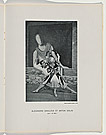Le Bal
Ballet in one act and two scenes
- Producer: Les Ballets Russes de Serge Diaghilev
- Premiere: 7 May 1929, Théâtre de Monte Carlo, Monaco
- Costume design: Giorgio de Chirico
- Costumier: A Youkine
- Scenery design: Giorgio de Chirico
- Music: Vittorio Rieti
- Choreography: George Balanchine
- Libretto: Boris Kochno, after a novel by Count Vladimir Sollogub
- Main characters: The Lady, the Young Man, the Astrologer, the Sylphides, the Italian guests, the Spanish guests, the Statue
A young man, dressed as a military officer, attends a masked ball where he meets a beautiful masked lady accompanied by an old astrologer, and falls in love with her, even as she flirts with his rival, a young Italian man. While overseen by the ballroom’s giant classical statue, which is possessed of magical powers, the sylphides mischievously dress to imitate the couple in order to confuse their suitors. The young man finally persuades the lady to remove her mask and is dismayed to see her as an old woman. He tries to leave but she pursues him, and as the ball ends the old woman leaves on the arm of the astrologer. As she passes the young officer she and the astrologer both remove further masks, revealing them as a beautiful young couple. Attempting to follow them, the dazed young officer is held back by the statue to contemplate his behaviour.
While the Italian Surrealist painter, Giorgio de Chirico, had worked in theatre design since 1924, his commission from Diaghilev for Le Bal gave him his most public success. As a version of the popular theme of the masked ball, the story’s dreamlike quality explored the nature of duplicity, ambiguity and deception. De Chirico drew upon his interest in desolate, unpeopled built spaces for his design of the ballroom, an austere room with exaggerated cornices, strangely proportioned openings and scattered with fragments of classical architecture. This theme is echoed in the guests’ costumes, rendering each performer a moveable element of an architectural ensemble. Jackets and trousers became pilasters and columns, shirts and dresses roughly sketched examples of the classical orders. Their complexity and weight was further laden with stuccoed wigs for the dancers, adding to an air of ossified antiquity even though Balanchine’s choreography was light and acrobatic. While the radicalism of rational modernism was taking hold in the late 1920s in Europe, de Chirico’s work for Le Bal is a vivid example of the Italian Novecento design movement that returned classicism to mainstream taste during the 1920s. It also echoed Diaghilev’s lifelong admiration for Italian history, and gained particular poignancy as his last production before his death in Venice one month after the closure of the ballet’s London season.




